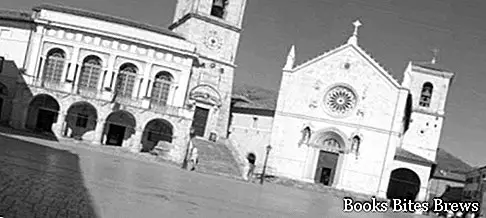What to see in Norcia, itinerary including the main monuments and places of interest including Basilica San Benedetto, Museo Castellina and Cathedral of Santa Maria Argentea.
Tourist information
Norcia rises at an altitude of 604 meters above sea level. at the northern limit of the Santa Scolastica plateau, in the heart of the Umbria-Marche Apennines.
The area where Norcia stands is rich in archaeological evidence attesting to the presence of man since the Middle Paleolithic.
The city was founded by the Sabines in the fifth century BC. and at the beginning of the third century BC it was conquered by the Romans, becoming a municipality after the social war which took place at the beginning of the 1st century BC.
Norcia and its territory were evangelized by San Feliciano, bishop of Foligno, starting from the middle of the third century. It was the seat of diocese in the fourth century, and in 480 the twin saints Benedetto and Scholastica were born in Norcia.
At that time the world was shocked by a profound crisis of values and institutions, due to the collapse of the Roman Empire and the arrival of new peoples.
Norcia was invaded by the Lombards and the city was agglomerated in the Duchy of Spoleto, it was in this historical phase that San Benedetto brought an authentic spiritual ferment that materialized with a new spiritual and cultural unity, overcoming his time and his homeland.
The Benedictine Rule based on the wise balance between prayer and work, from which the famous motto "Ora et labora" (pray and work) was derived, imposed itself on all Western monasticism.
The monks applied themselves in a wide variety of human activities, such as writing, music, architecture, crafts, land reclamation, medical arts, and the realization of food products, contributing greatly to the growth of humanity .
Continuing in the history of Norcia, in 1200 the town was born, which consolidated in the following century when the city walls were built.
In 1484 Norcia passed under the Pontifical Legation of Perugia, and in 1500 the papal commissioner took the place of the podestà.
Recommended readings- Umbria: Sunday day trips
- Gualdo Tadino (Umbria): what to see
- Ferentillo (Umbria): what to see
- Orvieto (Umbria): what to see
- Castiglione del Lago (Umbria): what to see
The first half of the 1600s was characterized by an important building, artistic and cultural renovation, but in the following century two earthquakes suddenly canceled what had been built after 1328.
Until the annexation to the Kingdom of Italy, excluding the Napoleonic period, Norcia was governed by the Papal States.
What see
The center of the city is represented by Piazza San Benedetto, where the main monuments are located.
– Basilica of San Benedetto, built in 1200 and remodeled several times. The crypt which in the local tradition is considered the birthplace of Benedict and Scholastica is very beautiful. The crypt leads to an archaeological area below the basilica. Adjacent to the right side of the church of San Benedetto is the portico of the measures built around 1570.
– Castellina it was built in 1554 on a design by Vignola, after being the seat of the prefecture and the papal governors, today it houses the civic and diocesan museum, the Massenzi collection and an archaeological exhibition, as well as various periodic exhibitions.
– Cathedral of Santa Maria Argentea, which stands on the remains of the ancient parish church, was built between 1560 and 1574, but has been restored several times due to earthquakes.
– Municipal building of Norcia dating back to 1300 based on a design by Domenico Mollajoli from Perugia, but only the lower part of the building and the portal remain from this period, due to damage caused by earthquakes.




